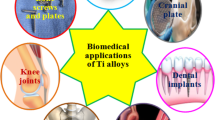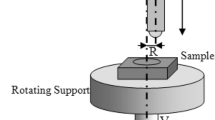Abstract
Titanium alloys are playing a vital role in the field of biomaterials due to their excellent corrosion resistance and biocompatibility. These alloys enhance the quality and longevity of human life by replacing or treating various parts of the body. However, as these materials are in constant contact with the aggressive body fluids, corrosion of these alloys leads to metal ions release. These ions leach to the adjacent tissues and result in adverse biological reactions and mechanical failure of implant. Surface modifications are used to improve corrosion resistance and biological activity without changing their bulk properties. In this investigation, electropolishing and magnetoelectropolishing were carried out on commercially pure titanium, Ti6Al4V, and Ti6Al4V-ELI. These surface modifications are known to effect surface charge, chemistry, morphology; wettability, corrosion resistance, and biocompatibility of these materials. In vitro cyclic potentiodynamic polarization tests were conducted in phosphate buffer saline in compliance with ASTM standard F-2129-12. The surface morphology, roughness, and wettability of these alloys were studied using scanning electron microscope, atomic force microscope, and contact angle meter, respectively. Moreover, biocompatibility of titanium alloys was assessed by growing MC3T3 pre-osteoblast cells on them.










Similar content being viewed by others
References
M. Long and H.J. Rack, Titanium Alloys in Total Joint Replacement—A Materials Science Perspective, Biomaterials, 1998, 19(18), p 1621–1639
H.J. Rack and J.I. Qazi, Titanium Alloys for Biomedical Applications, Mater. Sci. Eng. C, 2006, 26(8), p 1269–1277
A.C. August, C.H. Aldam, and P.B. Pynsent, The McKee-Farrar Hip Arthroplasty. A Long-Term Study, J. Bone Joint Surg. Br., 1986, 68, p 520–527
F.J. Schoen, J.E. Lemons, B.D. Ratner, A.S. Hoffman, B.D. Ratner, A.S. Hoffman, F.J. Schoen, and J.E. Lemons, Biomaterials Science: An Introduction to Materials in Medicine, 3rd ed., Academic Press, Waltham, 2001, p 35–42
L. Trentani, F. Pelillo, F.C. Pavesi, L. Ceciliani, G. Cetta, and A. Forlino, Evaluation of the TiMo12Zr6Fe2 Alloy for Orthopaedic Implants: In Vitro Biocompatibility Study by Using Primary Human Fibroblasts and Osteoblasts, Biomaterials, 2002, 23, p 2863–2869
B. Li and B.E. Logan, Bacterial Adhesion to Glass and Metal-Oxide Surfaces, Colloids Surf. B, 2004, 36, p 81–90
G. Manivasagam, D. Dhinasekaran, and A. Rajamanickam, Biomedical Implants: Corrosion and Its Prevention—A Review, Recent Pat. Corr. Sci., 2010, 2, p 40–54
B. Al-Mangour, R. Mongrain, E. Irissou, and S. Yue, Improving the Strength and Corrosion Resistance of 316L Stainless Steel for Biomedical Applications Using Cold Spray, Surf. Coat. Technol., 2013, 216, p 297–307
Y. Tanaka, H. Saito, Y. Tsutsumi, H. Doi, H. Imai, and T. Hanawa, Active Hydroxyl Groups on Surface Oxide Film of Titanium, 316L Stainless Steel, and Cobalt-Chromium-Molybdenum Alloy and Its Effect on the Immobilization of Poly(ethylene glycol), Mater. Trans., 2008, 49, p 805–811
J.B. Shamsul, A.Z. Nurhidayah, and C.M. Ruzaidi, Characterization of Cobalt-Chromium-HAP Biomaterial for Biomedical Application, J. Appl. Sci. Res., 2007, 3, p 1544–1553
M. Niinomi, Mechanical Properties of Biomedical Titanium Alloys, Mater. Sci. Eng. A, 1998, 243(1–2), p 231–236
T. Hryniewicz, R. Rokicki, and K. Rokosz, Magnetoelectropolished Titanium Biomaterial, Surf. Coat. Technol., 2009, 203(10–11), p 1508–1515
C. Oldani, A. Dominguez, and T. Eli, Titanium as a Biomaterial for Implants, Recent Advances in Orthoplasty, S.K. Fokter, Ed., InTech, Rijeka, 2012.
S. Roessler, R. Zimmermann, D. Scharnweber, C. Werner, and H. Worch, Characterization of Oxide Layers on Ti6Al4V and Titanium by Streaming Potential and Streaming Current Measurements, Colloids Surf. B, 2002, 26, p 387–395
S. Bauer, P. Schmuki, K. von der Mark, and J. Park, Engineering Biocompatible Implant Surfaces, Prog. Mater. Sci., 2013, 58(3), p 261–326
A. Cremasco, A.D. Messias, A.R. Esposito, E.A.D.R. Duek, and R. Caram, Effects of Alloying Elements on the Cytotoxic Response of Titanium Alloys, Mater. Sci. Eng. C, 2011, 31(5), p 833–839
I. Gurappa, Characterization of Different Materials for Corrosion Resistance Under Simulated Body Fluid Conditions, Mater. Charact., 2002, 49(1), p 73–79
S. Virtanen, I. Milosev, E. Gomez-Barrena, R. Trebse, J. Salo, and Y.T. Konttinen, Special Modes of Corrosion Under Physiological and Simulated Physiological Conditions, Acta Biomater., 2008, 4, p 468–476
R. Schenk, Titanium in Medicine: Material Science, Surface Science, Engineering, Biological Responses, and Medical Applications, Springer, New York, 2001, pp. 145–168
T. Hanawa, K. Asami, and K. Asaoka, Repassivation of Titanium and Surface Oxide Film Regenerated in Simulated Bioliquid, J. Biomed. Mater. Res., 1998, 40, p 530–538
A. Oyane, H.-M. Kim, T. Furuya, T. Kokubo, and T. Nakamura, Preparation and Assessment of Revised Simulated Body Fluids, J. Biomed. Mater. Res. A, 2003, 65, p 188–195
M.A. Khan, R.L. Williams, and D.F. Williams, In-Vitro Corrosion and Wear of Titanium Alloys in the Biological Environment, Biomaterials, 1996, 17, p 2117–2126
H. Shen and L.C. Brinson, A Numerical Investigation of Porous Titanium as Orthopedic Implant Material, Mech. Mater., 2011, 43(8), p 420–430
F. Rupp, L. Scheideler, N. Olshanska, M. de Wild, and J. Geis-Gerstorfer, Enhancing Surface Free Energy and Hydrophilicity Through Chemical Modification of Microstructured Titanium Implant Surfaces, J. Biomed. Mater. Res. A, 2006, 76, p 323–334
J.I. Rosales-Leal et al., Effect of Roughness, Wettability and Morphology of Engineered Titanium Surfaces on Osteoblast-Like Cell Adhesion, Colloids Surf. A, 2010, 365, p 222–229
P.I. Brånemark, Osseointegration and Its Experimental Background, J. Prosthet. Dent., 1983, 50, p 399–410
D.D. Deligianni, N.D. Katsala, P.G. Koutsoukos, and Y.F. Missirlis, Effect of Surface Roughness of Hydroxyapatite on Human Bone Marrow Cell Adhesion, Proliferation, Differentiation and Detachment Strength, Biomaterials, 2001, 22, p 87–96
J.E. Feighan, V.M. Goldberg, D. Davy, J.A. Parr, and S. Stevenson, The Influence of Surface-Blasting on the Incorporation of Titanium-Alloy Implants in a Rabbit Intramedullary Model, J. Bone Joint Surg. Am., 1995, 77, p 1380–1395
R.B. Alvarez, H.J. Martin, M.F. Horstemeyer, M.Q. Chandler, N. Williams, P.T. Wang, and A. Ruiz, Corrosion Relationships as a Function of Time and Surface Roughness on a Structural AE44 Magnesium Alloy, Corros. Sci., 2010, 52, p 1635–1648
L.-C. Xu and C.A. Siedlecki, Effects of Surface Wettability and Contact Time on Protein Adhesion to Biomaterial Surfaces, Biomaterials, 2007, 28, p 3273–3283
J.Y. Lim, M.C. Shaughnessy, Z. Zhou, H. Noh, E.A. Vogler, and H.J. Donahue, Surface Energy Effects on Osteoblast Spatial Growth and Mineralization, Biomaterials, 2008, 29, p 1776–1784
W. Haider, Enhanced Biocompatibility of NiTi (Nitinol) Via Surface Treatment and Alloying,” FIU Electronic Theses and Dissertations, Paper 177, 2010
K. Kieswetter, Z. Schwartz, T.W. Hummert, D.L. Cochran, J. Simpson, D.D. Dean, and B.D. Boyan, Surface Roughness Modulates the Local Production of Growth Factors and Cytokines by Osteoblast-Like MG-63 Cells, J. Biomed. Mater. Res., 1996, 32, p 55–63
G.B. Sigal, M. Mrksich, and G.M. Whitesides, Effect of Surface Wettability on the Adsorption of Proteins and Detergents, J. Am. Chem. Soc., 1998, 120, p 3464–3473
B. Feng, J. Weng, B.C. Yang, S.X. Qu, and X.D. Zhang, Characterization of Surface Oxide Films on Titanium and Adhesion of Osteoblast, Biomaterials, 2003, 24, p 4663–4670
L. Ponsonnet, K. Reybier, N. Jaffrezic, V. Comte, C. Lagneau, M. Lissac, and C. Martelet, Relationship Between Surface Properties (Roughness, Wettability) of Titanium and Titanium Alloys and Cell Behaviour, Mater. Sci. Eng. C, 2003, 23, p 551–560
L. Le Guéhennec, A. Soueidan, P. Layrolle, and Y. Amouriq, Surface Treatments of Titanium Dental Implants for Rapid Osseointegration, Dent. Mater., 2007, 23, p 844–854
Z. Ahmad, Principles of Corrosion Engineering and Corrosion Control, Wiley Canada, Limited, Mississauga, 1999, p 271–351
M. Geetha, A.K. Singh, R. Asokamani, and A.K. Gogia, Ti Based Biomaterials, the Ultimate Choice for Orthopaedic Implants—A Review, Prog. Mater Sci., 2009, 54(3), p 397–425
V.P. Zhdanov and B. Kasemo, Cabrera-Mott Kinetics of Oxidation of nm-Sized Metal Particles, Chem. Phys. Lett., 2008, 452, p 285–288
Acknowledgments
W. Haider would like to acknowledge 2013 Ralph E. Powe Junior Faculty Enhancement Award. Authors would like to acknowledge Dr. Shivani Maffi and Mr. Alfonso Salinas for tissue culture training and SEM, respectively.
Author information
Authors and Affiliations
Corresponding author
Rights and permissions
About this article
Cite this article
Rahman, Z., Pompa, L. & Haider, W. Influence of Electropolishing and Magnetoelectropolishing on Corrosion and Biocompatibility of Titanium Implants. J. of Materi Eng and Perform 23, 3907–3915 (2014). https://doi.org/10.1007/s11665-014-1205-3
Received:
Revised:
Published:
Issue Date:
DOI: https://doi.org/10.1007/s11665-014-1205-3




